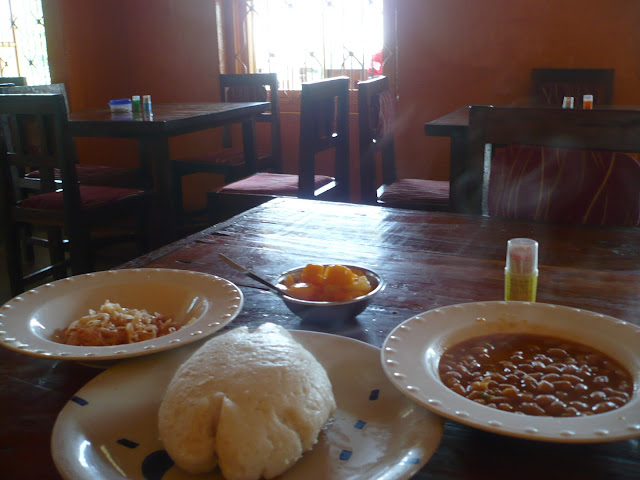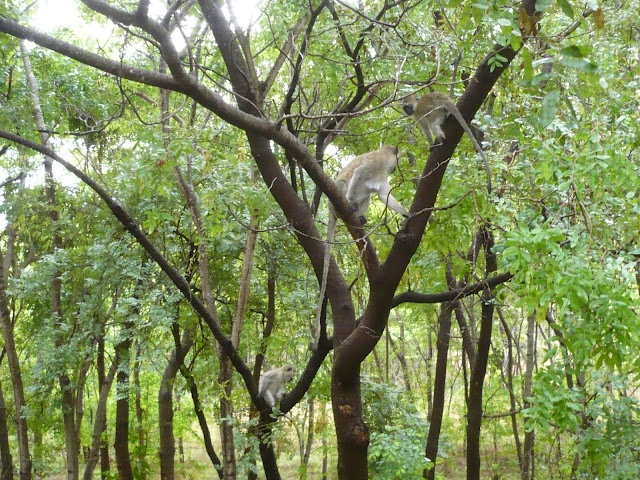While in Kigoma I discovered a beautifully packaged jar of honey at a shop near the market. The label displayed a professional logo for Mzinga Honey (mzinga means "beehive" in Swahili), complete with barcode, tamper-proof lid, packaging date, and a small pamphlet describing the methods used by Kasulu beekeepers for harvesting and processing. Someone in the Europe or the U.S. would probably take these things for granted, but in Tanzania it is a very big accomplishment! Even more, the price for this treasure was the same as the prices being asked for sub-par honey packaged in old bottles of water or spirits with obvious fermentation and bee gunk floating on the surface.

Though my exploration of beekeeping is not honeycentric, the end-product of apiculture is a good starting point for finding hives and beekeepers. Moreover, the well-crafted jar from Kasulu (and the delicious honey within) represents successes that elude so many Tanzanian beekeepers - finding a market, including beekeepers in the business process, maintaining the perfection of the honey from hive to shelf, obtaining packaging materials, and sustaining a cooperative (unlike the failed Tabora Beekeepers Cooperative Society).
I called the phone number from the label and reached Staford Nkubhagana, the project manager for the Kasulu Beekeepers Cooperative Society. He invited me to visit him and the beekeepers in Kasulu. I never know what to expect when someone in Tanzania invites me to his or her place of business. Sometimes it is only to ask me for funding or sponsorships (which is a lost cause when they are talking to me) and sometimes it is just for me to sign the guestbook - which I have found is a practice of very high priority - while offering nothing else productive. However, as was the case for Kasulu, these invitations sometimes yield very meaningful discussions and amazing new opportunities.
Delayed by rain and afraid of buses I opted for a dala dala from Kigoma to Kasulu. In a previous post I mentioned that these small passenger vans are chronically overcrowded (twenty-two people or more in a van with enough chairs to uncomfortably seat fourteen), and this one was no exception, yet I enjoyed it much more than my previously harrowing journey by bus. Albeit incredibly uncomfortable, it was fun watching the various people jump on and jump off with various goods as they traveled between villages. The one exception was the mama who boarded with three buckets of freshly caught dagaa (little fish) which leaked fish juice throughout the van and added a new level of repugnance to the already stale air within. After two hours of travel and changing 'seats' four times to accommodate the ever increasing number of passengers (from the spot by the door, to standing in the aisle, to sitting in the aisle, to ending in a breezy seat by a window) I finally arrived in Kasulu with two sleeping children on my lap and a renewed appreciation for the inventiveness and endurance of the Tanzanian people.

The Kasulu Beekeepers Cooperative Society began as an organization for beekeepers in 1998 with 198 members in five groups from all over Kasulu District of Kigoma Region. By 2002 the organization was officially a cooperative society and had grown to ten groups with 256 members. The current numbers include 372 members in sixteen groups. At the present time, members of the society lay claim to 2,560 box style (Tanzanian Top Bar) hives and 13,376 local style hives, which are of two varieties - bark style and grass style.
In 2002 and 2003 CARE, an American non-profit, offered financial aid and the
assistance of two Austrian technical advisors who were pivotal in establishing
Mzinga Honey, to KBCS. These two taught techniques for
maintaining honey and wax quality, introduced the use of protectives (bee
veils, gloves, etc.), and were probably the first to demonstrate the use of
Tanzanian Top Bar Hives. Their financial resources were used to purchase the land and
buildings now used for office space and honey processing. Mr.
Nkubhagana was hired as project manager at this time and has directed the
cooperative ever since.
 |
| Kasulu Beekeepers Cooperative Society headquarters |
 |
| Joseph M. Halala, Secretary (left) and Staford Nkubhagana, Project Manager (right) in the KBCS office. |
The CARE project with KBCS was very successful; the cooperative and Mzinga Honey have been operating
independently since 2003. The key to this success, I think, was that the
Austrian technical advisors recognized the importance of developing a
sustainable system of managment and operation for the cooperative. They
demonstrated box hives, but acknowledged that local style hives were more affordable and could be used
just as effectively. They didn't build a mechanical wonder of a processing
facility for honey and wax, but opted to use methods which can be carried out
with everyday materials (charcoal, pots and pans, mosquito nets, buckets, etc).
Also, they designed a timeless label and developed contacts with suppliers in Nairobi, Kenya for
acquiring bottling materials. Finally, they invested directly in a person, Mr.
Nkubhagana, who has been the most important player in holding the cooperative
together. It seems risky to stack your bets on one individual rather than many,
but it has been okay so far. KBCS also has a board of six members who set annual prices and make other important decisions concerning the beekeepers. CARE maintains an office nearby
which has moved on to other projects but still offers some resources to KBCS like
internet access and a printer.
 |
| This example of a grass style hive is built by weaving together dry grasses and bamboo. Visible here is the outer weather protective layer which can be replaced every few years without damaging the bees inside. Beekeepers report that this hive can be maintained for 5 to 6 years before needing maintenance and that they can harvest 10 to 15 liters from it per harvest. |
While I was in Tabora I was very interested in how many honey processing/packaging facilities existed in the country. I was told that Honey King and Honey Care both had factories in Dar es Salaam, but that there were no more other than the facility once used by the Tabora Beekeepers Cooperative Society in Kipalapala. The rest of the nation's honey was being processed in Nairobi. I was surprised and discouraged, but I have since learned that the definition of honey processing held by myself and the government was entirely too narrow. We were only thinking in terms of giant stainless steel vessels of honey, loud machinery, and mechanized packaging, which was a mistake. In reality there are many entrepreneurs around the country who are manually cleaning honey using a two screen-filtration process and then bottling with their own labels. In fact, most shops selling honey in Tanzania have a large room in the back where honey is cleaned in this way. Proper plastic jars are notoriously difficult to acquire - some are available from Dar es Salaam, but most come from Nairobi - and glass jars are out of the question (I have heard two people mention attempting to import from Egypt). KBCS is processing and packaging honey and rendering wax in a way that doesn't even require electricity, but their methods are perfectly adequate and it would be ridiculous for anyone to say otherwise.
Beekeepers from around Kasulu bring their buckets of comb honey to the collection center where it is weighed and checked for quality. Most merchants I have met buy wax and honey separately (the wax is melted into a hole in the ground and the honey is roughly filtered at the beekeeper's forest camp). If everything is in order the beekeeper is paid by the kilogram of wax/honey (1 kg comb honey = 0.65 kg of pure honey). During the big harvest seasons (June and October) temporary workers are hired by KBCS to process and package as much as seven tons of honey.
 |
| The comb honey is pulverized with a fork and knife and placed on top of a screen tied over a bucket. The honey passes through the screen and fills the bucket, which completes the first step of filtration. |
 |
| The honey from the first bucket is then poured onto a finer screen in a different bucket and left to filter. The honey at the bottom of this bucket is the final product and is ready to be bottled. |
 |
| Mr. Nkubhagana bottles the honey. The only task that remains is to add the label. |
Processing wax is more labor intensive than processing honey. First, the empty comb is recovered from the honey cleaning process and is placed in boiling water to remove excess honey.
 |
| As the wax melts it is poured into this screen and pushed through with a paddle to filter out any debris. The wax is collected in buckets of various shapes and sizes and allowed to set, which separates the wax from excess water. |
 |
| The set wax is broken up and melted by indirect heating (a vessel with only wax floating in a vessel of boiling water). Once fully melted the wax is passed through a fine mesh to remove small particulate matter missed in the previous filtration. |
 |
| All of the heating is done using charcoal stoves. Charcoal stoves are the primary means of cooking food too. |
 |
| After the second filtration, the melted wax is poured into candle molds or large containers for bulk sell. |
Unfortunately there isn't a market for wax in Tanzania or anywhere in East Africa. These candles would be sold for 1,000TZS (sixty cents) locally, but paraffin wax candles from China are readily available, less expensive, and favored by most Tanzanians. Export of wax to Europe and the United States, where it is used in cosmetics and furniture polish or turned into foundation for Langstroth Hives can be very profitable and is the best option available. Many traders are already doing this.
Tanzania is also lacking a reliable market for honey, which is very disappointing because the country is capable of producing so much and could produce even more. Honey is superabundant in much of the country (Tabora alone probably produces enough to satisfy the local demand) which greatly reduces the price. The prices are better when sold in Dar es Salaam. The problem is that most Tanzanians do not consume honey as a table food. It is mostly used as medicine and not a regular part of the diet. Fortunately, surrounding countries where honey is consumed regularly, like Rwanda, Uganda, and Kenya, are producing very little honey (I was told that 80% of the honey consumed in Kenya is from Tanzania) which means a market is very close if someone has the resources and contacts to transport their products out of the country. Many Ugandan and Kenyan merchants are coming here themselves. I should also mention that Tanzanian honey meets EU standards for export and businesses like Honey Care are sending honey to Germany, but I think the best option is to capitalize on the market in East Africa.





















































